US inflation slips from 4.9% to 4% in May, the lowest in two years
On a month-on-month basis, the consumer price index data reduced from 0.4 per cent to 0.1 per cent, the Labor Department said.
)
U.S. consumer prices rose moderately in May, leading to the smallest annual increase in inflation in more than two years, though underlying price pressures remained strong, supporting views that the Federal Reserve would keep interest rates unchanged on Wednesday while adopting a hawkish posture.
The Consumer Price Index (CPI) increased 0.1 per cent last month as gasoline prices fell, the Labor Department said on Tuesday. The CPI gained 0.4 per cent in April. In the 12 months through April, the CPI climbed 4.0 per cent. That was the smallest year-on-year increase since March 2021 and followed a 4.9 per cent rise in April.
The annual CPI peaked at 9.1 per cent in June 2022, which was the biggest increase since November 1981, and is subsiding as last year's large rises drop out of the calculation.
Economists polled by Reuters had forecast the CPI gaining 0.2 per cent last month and increasing 4.1 per cent year-on-year.
The report was published as Fed officials prepared to gather for a two-day policy meeting.
Data this month offered a mixed picture of the labor market, with nonfarm payrolls increasing solidly in May, but the unemployment rate rising to a seven-month high of 3.7 per cent from a 53-year low of 3.4 per cent in April.
Economists believe that the gradual inflation and labor market slowdown gives the U.S. central bank enough room to skip raising interest rates on Wednesday for the first time since March 2022 when the Fed embarked on its fastest monetary policy tightening campaign in more than 40 years.
The Fed, which has hiked its policy rate by 500 basis points, is expected to leave the door open to further rate increases.
With the economy showing signs of slowing, economists argue that the Fed should pause further rate increases while assessing the impact of the steps its has taken so far to cool demand.
Overall inflation is decelerating, thanks to energy and food costs.
Food commodity prices have dropped back to levels seen prior to Russia's invasion of Ukraine.
Inflation is, however, proving to be sticky excluding these volatile categories, and remains well above the Fed's 2 per cent target.
The so-called core CPI increased 0.4 per cent in May, rising by the same margin for the third straight month.
High rents continued to put upward pressure on the core CPI, with used cars and trucks also providing a boost.
The rise in used cars and trucks reflects the delayed impact of increases during winter and early spring.
Beyond May, however, core inflation is expected to slow, driven by a moderation in rents and resumption in price declines for used cars and trucks.
The rental vacancy rate rose to a two-year high in the first quarter, while independent measures have been showing rents on a downward trend.
Rent measures in the CPI tend to lag the independent gauges by several months. In the 12 months through May, the core CPI climbed 5.3 per cent after increasing 5.5 per cent in April.
Get Latest Business News, Stock Market Updates and Videos; Check your tax outgo through Income Tax Calculator and save money through our Personal Finance coverage. Check Business Breaking News Live on Zee Business Twitter and Facebook. Subscribe on YouTube.
RECOMMENDED STORIES

SBI 444-day FD vs Union Bank of India 333-day FD: Know maturity amount on Rs 4 lakh and Rs 8 lakh investments for general and senior citizens

Power of Compounding: Salary Rs 25,000 per month; is it possible to create over Rs 2.60 crore corpus; understand it through calculations

New Year Pick by Anil Singhvi: This smallcap stock can offer up to 75% return in long term - Check targets

Power of Compounding: How many years it will take to reach Rs 2 crore corpus if your monthly SIP is Rs 3,000, Rs 4,000, or Rs 5,000

Retirement Calculator: 40 years of age, Rs 50,000 monthly expenses; what should be retirement corpus and monthly investment
07:51 AM IST








 Why US CPI data is an indicator for economies around the world
Why US CPI data is an indicator for economies around the world US CPI Data for March: Release date, time, all you need to know
US CPI Data for March: Release date, time, all you need to know Indian rupee to dollar: Here is a major mark currency may cross
Indian rupee to dollar: Here is a major mark currency may cross